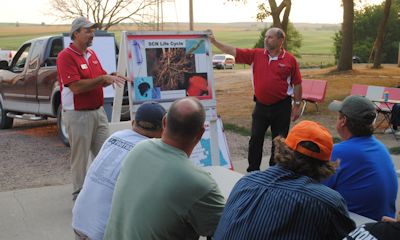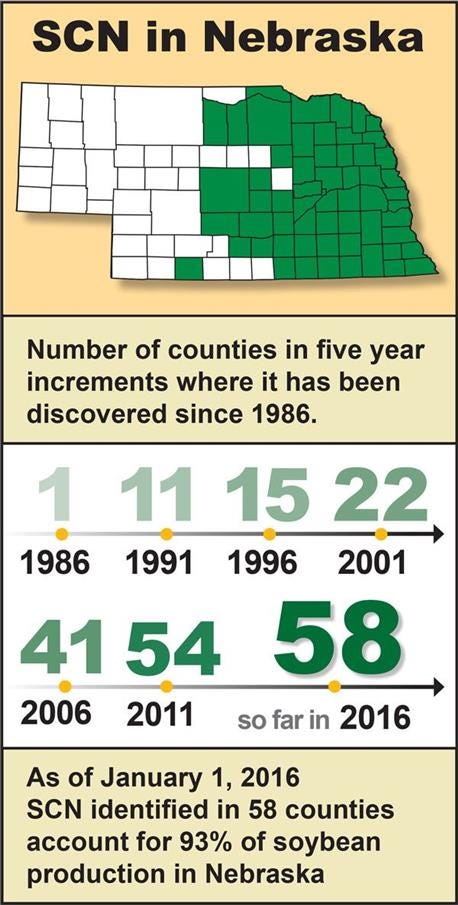
Soybean Cyst Nematode, dubbed the "silent yield robber" for soybeans, was first confirmed in Richardson County in the far southeast corner of Nebraska in 1986. Now, 30 years later, it has been confirmed in 58 counties and has marched west and north into nearly every corner of the state where soybeans are grown.

EDUCATION: Wilson (right) and Nebraska Extension plant pathologist, Loren Giesler, have teamed up to increase awareness of SCN through presentations and field tours, like this program at a farm near Randolph.
This small plant-parasitic roundworm attacks soybean roots. Above ground symptoms are difficult to pin down, because SCN injury reminds growers of other maladies like compaction, iron deficiency chlorosis, drought stress or herbicide injury. The first obvious symptom is the appearance of oval-shaped areas of stunted, yellow plants. Often, growers do not notice these symptoms, but they do notice unexpected yield losses in those fields at harvest time.
Nebraska Extension plant pathologist, Loren Giesler and Nebraska Extension educator, John Wilson, have been on the front lines in the battle to test for SCN and combat it in the field. "After SCN was confirmed in Richardson County in the summer of 1986, there was someone from UNL's plant pathology department doing random sampling in the first few tiers of counties west of the Missouri River in 1987 and 1988," Wilson says. "That is why there were 10 counties confirmed during those two years." From 1989 to 2004, random sampling was conducted and many farmers were not aware of a need to test.

MARCH OF SCN: Soil testing for SCN, supported by Nebraska Soybean Board, has been instrumental in confirming SCN as it has marched across the state over the past 30 years, says Nebraska Extension educator, John Wilson.
"I personally confirmed SCN in Washington County in 1994 and Thurston County in 1999," Wilson recalls. "We coordinated a sampling project in Burt, Cuming, Dodge and Washington counties which led to confirmations in Cuming and Dodge counties in 1998, but from 1986 to 2004, there were only 27 counties confirmed in 19 years, which is less than two counties per year."
Thanks to Nebraska Soybean Board sponsorship of a sampling program covering the cost of SCN analysis for all Nebraska farmers beginning in 2005, awareness and detection of SCN has greatly increased. "This really increased detection, adding 14 counties in the first two years of the program and in the first seven years, identifying as many counties as had been identified in the previous 19 years," Wilson explains. "We continue to pick up a county or two every year, but it is getting less likely to discover new counties because the counties that have been identified so far produce 93-94% of Nebraska's soybeans."
Identifying the existence of SCN in a field through testing and planting resistant varieties are the best methods of prevention, Wilson says.
You can learn more about SCN by contacting Wilson at 402-374-2929 or Giesler at 402-472-2559.
About the Author(s)
You May Also Like






